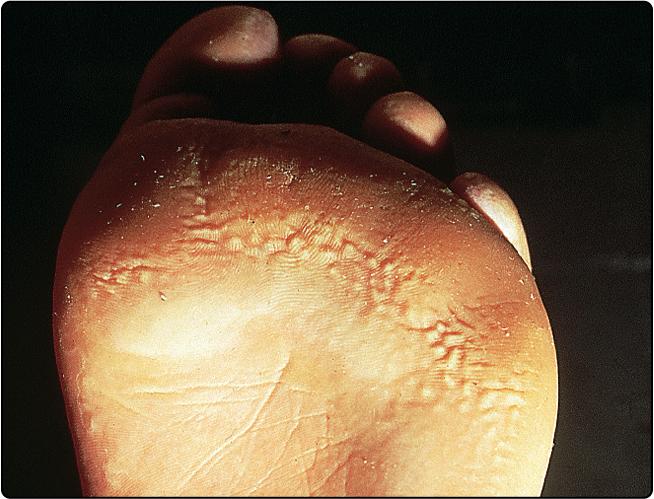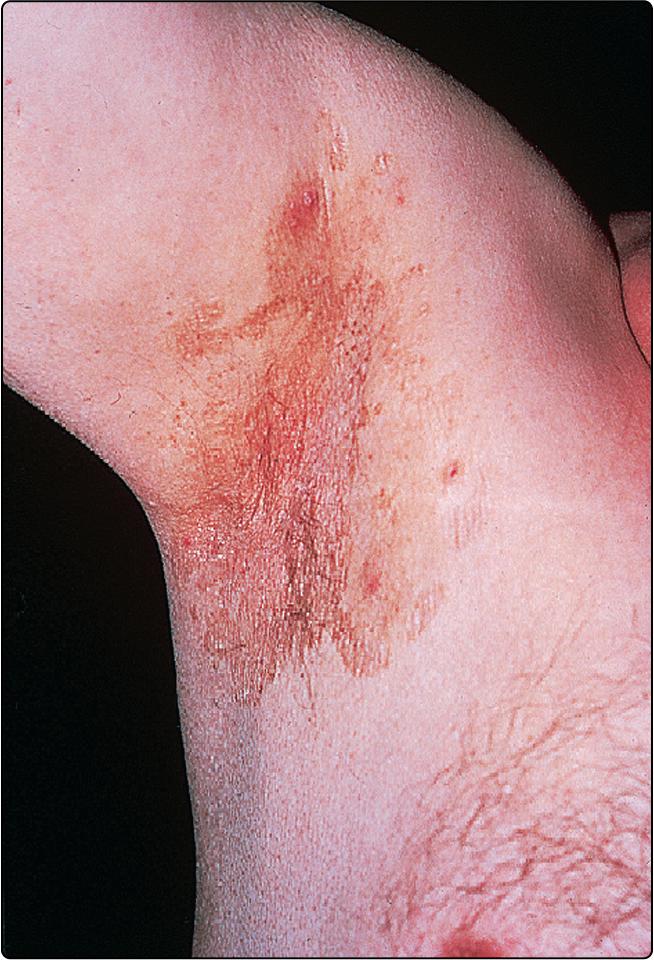Physical Address
304 North Cardinal St.
Dorchester Center, MA 02124
Sometimes, ‘normal’ commensals can result in disease. Among the most common are the following:
Pitted keratolysis . Overgrowth of resident microorganisms that digest keratin; occurs with occluding footwear and sweaty feet ( Fig. 28.1 ). Malodorous pitted erosions and punched out, discoloured areas result. Better hygiene, topical neomycin or soaks with 0.01% aqueous potassium permanganate or 3% aqueous formaldehyde usually help.

Erythrasma. A dry, reddish–brown, slightly scaly and usually asymptomatic eruption that affects the body folds ( Fig. 28.2 ). It fluoresces coral pink with Wood’s light, owing to the production of porphyrins by the corynebacteria. Imidazole creams, topical fusidic acid or oral erythromycin are effective.

Trichomycosis axillaris. Overgrowths of corynebacteria form yellow concretions on axillary hair. Topical antimicrobials usually effect a cure.
Mycobacterium tuberculosis and M . leprae ( Chapter 26 ) are the most important mycobacteria in human disease, although other species can cause infections. In Western countries, tuberculosis (TB) has recently shown resurgence, related to immigration and co-infection with HIV. In the developing world, 50% of HIV-infected individuals also have TB. Individuals treated with anti-TNF biologics (e.g. for psoriasis) are at particular risk and latent TB should be excluded before treatment. TB can produce a number of cutaneous manifestations ( Table 28.1 ).
| Lupus vulgaris: reddish–brown plaques, e.g. on the neck. |
| Tuberculides: cutaneous hypersensitivity reactions. |
| Scrofuloderma: skin involved from underlying node. |
| Warty tuberculosis: warty plaques, e.g. on buttock. |
Diagnosis of mycobacterial infections in the skin is confirmed with microbiological culture from a skin biopsy. This requires specific culture conditions so the clinical information should be made clear to the laboratory staff. Culture results are usually very delayed and can take 8–12 weeks. Following confirmation by culture, PCR analysis for mycobacterial DNA is useful to identify mycobacterial subtypes and can give a clue to the likelihood of resistance to therapy, but requires a high mycobacterial load in the sample to gain positive results and is not generally useful for diagnostic testing. Skin histology can identify acid fast bacilli with Ziehl–Neelsen staining but this is unreliable. T-cell interferon-γ release assays (IGRAs) to the M. tuberculosis antigen are highly specific (for current or latent infection) and reasonably sensitive and have largely replaced other tests. Although IGRAs may show positivity with mycobacteria other than TB, this is variable and not reliable for diagnosis. The most widely used IGRAs are:
QuantiFERON-TB Gold In-Tube test (QFT-GIT)
T-SPOT.TB test (T-Spot).
Reddish–brown plaques, often on the head or neck, characterize lupus vulgaris. It is the commonest M . tuberculosis skin infection.
Become a Clinical Tree membership for Full access and enjoy Unlimited articles
If you are a member. Log in here